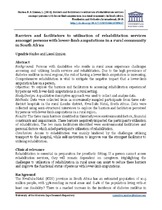| dc.contributor.author | Naidoo, Ugendrie | |
| dc.contributor.author | Ennion, Liezel | |
| dc.date.accessioned | 2018-09-17T12:41:05Z | |
| dc.date.available | 2018-09-17T12:41:05Z | |
| dc.date.issued | 2018 | |
| dc.identifier.citation | Naidoo, U. & Ennion, L. (2018). Barriers and facilitators to utilisation of rehabilitation services amongst persons with lower-limb amputations in a rural community in South Africa. Prosthetics and Orthotics International, 2018. | en_US |
| dc.identifier.issn | 0309-3646 | |
| dc.identifier.uri | http://dx.doi.org/10.117/0309364618789457 | |
| dc.identifier.uri | http://hdl.handle.net/10566/4049 | |
| dc.description.abstract | BACKGROUND: Persons with disabilities who reside in rural areas experience challenges accessing and utilising health services and rehabilitation. Due to the high prevalence of diabetes mellitus in rural regions, the risk of having a lower-limb amputation is increasing. Comprehensive rehabilitation is vital to mitigate the negative impact that a lower-limb amputation has on a person.
OBJECTIVE: To explore the barriers and facilitators to accessing rehabilitation experienced by persons with lower-limb amputations in a rural setting.
STUDY DESIGN: A qualitative descriptive approach was used to collect and analyse data.
Methods: Data were collected from 11 conveniently sampled participants from three sub-district hospitals in the rural iLembe district, Kwa-Zulu Natal, South Africa. Data were collected using semi-structured interviews to explore the barriers and facilitators perceived by persons with lower-limb amputations in a rural region.
RESULTS: The three main barriers identified in this study were environmental factors, financial constraints and impairments. These barriers negatively impacted the participant’s utilisation of rehabilitation. The two main facilitators identified were environmental facilitators and personal factors which aided participant’s utilisation of rehabilitation.
CONCLUSION: Access to rehabilitation was mainly hindered by the challenges utilising transport to the hospital, while self-motivation to improve was the strongest facilitator to utilising rehabilitation. | en_US |
| dc.language.iso | en | en_US |
| dc.publisher | SAGE Publications | en_US |
| dc.rights | This is the author-version of the article published online at: http://dx.doi.org/10.117/0309364618789457 | |
| dc.subject | Amputation | en_US |
| dc.subject | Lower-limb | en_US |
| dc.subject | Barriers | en_US |
| dc.subject | Facilitators | en_US |
| dc.subject | Rural | en_US |
| dc.subject | KwaZulu-Natal | en_US |
| dc.subject | Utilisation | en_US |
| dc.title | Barriers and facilitators to utilisation of rehabilitation services amongst persons with lower-limb amputations in a rural community in South Africa | en_US |
| dc.type | Article | en_US |
| dc.privacy.showsubmitter | FALSE | |
| dc.status.ispeerreviewed | TRUE | |

